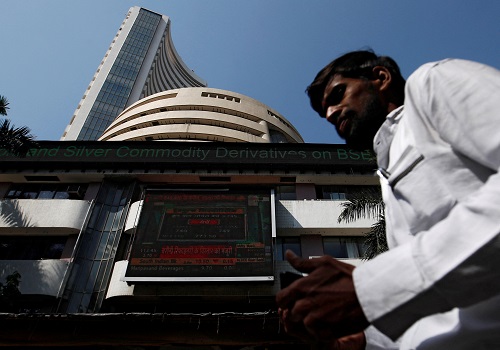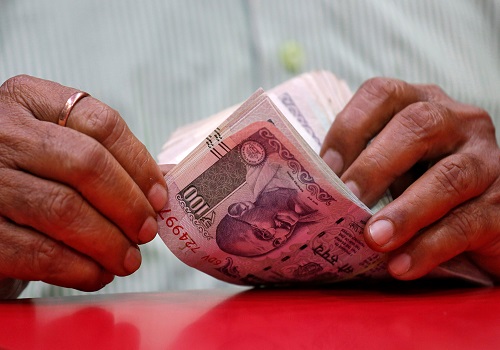Agri Picks Daily Technical Report 11 February 2021 - Geojit Financial

Follow us Now on Telegram ! Get daily 10 - 12 important updates on Business, Finance and Investment. Join our Telegram Channel
SPICES
* Better crop prospects and tepid export demand capped gains in Jeera NCDEX March futures on Wednesday.
* According to the second advance estimates released by the Gujarat’s farm department, production in jeera is expected to be at 373700 tonnes in 2020-21 compared to 375420 tonnes produced last year (2019-20).
* According to Gujarat's farm department, as of 28 Dec2020, jeera has been sown across 464469 hectares in state, compared to 435657 hectares sown during the same period last year.
* Spices Board pegs Apr-Sep jeera exports at 153000 tonnes, up by 33 per cent on yoy basis.
* Exports of jeera were at 210,000 tn, up 16% from 180,300 tn in 2018-19 according to the Spices Board.
* NCDEX Coriander April futures continued rising and on Wednesday it ended on a positive note on good demand for the new crop.
* Coriander production in Gujarat is expected to rise 55 per cent to 216680 tonnes in 2020-21 season (Jul-Jun) due to sharp rise in acreage according to the state’s farm department’s second advance estimates.
* As of Dec 28, 2020 coriander has been sown across 135563 hectares compared to 76904 hectares sown during the same period last year showed the data from the Gujarat state farm department.
* According to Spices Board of India data, coriander exports for the Apr-Sep period this year is seen at 26750 tonnes, up by nine per cent on yoy basis.
* Coriander exports from India were up 3% on year at 50,250 tn in the last financial year according to the Spices Board.
* Uptrend continued in NCDEX Turmeric April futures on expectation of smaller crop and firm demand. It climbed to its highest level since May 2018 on Wednesday.
* Spices Board pegs turmeric export from India for the period Apr-Sep this year at 99000 tonnes, up by 42 per cent year on.
* India exported 136,000 tn of turmeric in 2019-20, up 2% on year according to the Spices Board.
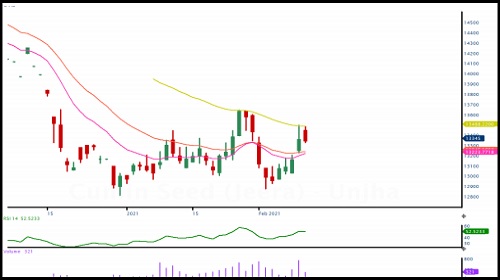
OILSEED
* Except Mustard seed, all commodities in the edible complex settled the day in negative note. MCX Feb CPO settled the day in negative note tracking weakness in global edible oil prices. Mar Soy oil prices also traded lower due to weakness in benchmark U.S CBOT soybean oil prices.
* NCDEX Mar soybean trailed lower as traders refrained to buy soymeal at higher prices. Apr NCDEX Mustard seed prices traded higher due to demand from oil millers amid shortage of stocks in the spot market.
* India's soymeal exports in Oct-Jan nearly tripled on year to 950,000 tn, data from The Soybean Processors Association of India showed. Soymeal exports in Oct-Jan a year ago were at 294,000 tn.
* The USDA has scaled up its estimate for global oilseed production in 2020-21 to 595.1 mln tn from 594.5 mln tn projected in January. The likely rise in overall production can be attributed to higher soybean output. They raised its forecast for global soybean crop to 361.1 mln tn from 361.0 mln tn projected last month. The agency also cut its estimate for closing stocks of oilseeds to 95.6 mln tn from 96.5 mln tn projected the previous month. Global oilseed trade in 2020-21 is projected at 193.9 mln tn, up from the agency's previous estimate of 192.7 mln tn. The estimate for global soybean stocks was reduced by 1.0 mln tn to 83.4 mln tn as lower stocks in the US and Brazil offset higher stocks in Argentina. The agency maintained its estimate for soybean output in the US at 112.6 mln tn, Brazil at 133.0 mln tn, and Argentina at 48 mln tn in 2020-21.
* India is likely to produce around 10 mln tn of mustard in 2020-21 (Jul-Jun), up 35% from a year ago, due to higher acreage and favourable weather conditions, according to the Solvent Extractors' Association of India.
* The government has proposed agriculture infrastructure and development cess on key edible oils in the Union Budget for 2021-22 (Apr-Mar). In the case of crude palm oil, the cess would lead to rise in overall effective duty by 5.5 percentage points to 35.75%. No major changes is seen in effective crude soyoil duty and crude sunflower oil.
* Soymeal exports were at 251,221 tn in December against 72,233 tn a year ago, while in Apr-Dec, soymeal exports were at 888,202 tn compared with 569,349 tn a year ago, according to data released by The Solvent Extractors' Association of India. Mustard meal exports in Apr-Dec were at 141,866 tn, up around 136% from a year ago.
* India's vegetable oil imports rose over 20% on year to around 1.35 mln tn in December, according to SEA.
* As on Dec 31, farmers, processors, stockists and state-run agencies had around 400,000 tn stock, compared with nearly 1.2 mln tn a year ago, according to Mustard Oil Producers Association of India.
* Farmers in the country have sown mustard across 6.9 mln ha, up 10.6% on year, in 2020-21 (Jul-Jun) season so far, data from the farm ministry.
* Indian government slashed import duty of crude palm oil. The government cut import duty on crude palm oil by 10% to 27.5%, in the last week, to cool off soaring edible oil prices in domestic markets. • The area under major kharif crops so far in 2020-21 (Jul-Jun) was at 111.7 mln ha, up nearly 5% from a year ago, farm ministry data showed. The area under soybean across the country rose 6.4% on year to 12.12 mln ha as of 24th Sep, according to data from the farm ministry. The Union Cabinet approved a hike in minimum support price for 14 major kharif crops. MSP for soybean hiked by Rs.170 to 3880 from 3710 per 100 kg. Soybean output is estimated at 12.2 mln tn in 2019-20, according to the farm ministry's fourth advance estimate.
* India is likely to grow a record 10 mln tn mustard crop in 2020-21 (Jul-Jun), mainly due to the likelihood of a sharp rise in acreage, according to Solvent Extractors' Association of India. The government has targeted an alltime high crop of 12.5 mln tn for this rabi season. The government has fixed the minimum support price at 4,650 rupees per 100 kg for 2020-21 (Apr-Mar) marketing season against 4,425 rupees per 100 kg the previous year.
* According to the first advance estimates for 2020-21 (Jul-Jun), castor seed output is seen at 1.7 mln tn compared with 1.8 mln tn in the fourth advance estimates for 2019-20, according to the data released by the farm ministry. While, according to traders, crop is seen at 1.5-1.6 mln tn. Farmers have sown castor seed across 792,000 ha in 2020-21 (Jul-Jun), down 16% from a year ago.
* India's castor oil exports jumped 41.6% on year to 53,007 tn in September, according to data from Solvent Extractors' Association of India. The exports have surged 28% from 41,408 tn in August. India's castor meal exports plunged by 26% on year to 54,885 tn in October from 73,832 tonnes, according to data released by The Solvent Extractors' Association of India. Moreover, overall export of oil meals during Apr-Oct plunged 43% on year to 382,238 tn.
* Malaysia's crude palm oil output plunged 15.5% on month to 1.13 mln tn in January, according to Malaysian Palm Oil Board. Total palm oil stocks in the country rose 4.7% on month to 1.32 mln tn. Exports of palm oil in January slumped 42.3% on month to 947,395 tn and those of biodiesel fell 76.5% on month to 10,081 tn.
* During Feb 1-10, exports from Malaysia rose 47% on month to 399,529 tn, according to data released by cargo surveyor AmSpec Agri Malaysia
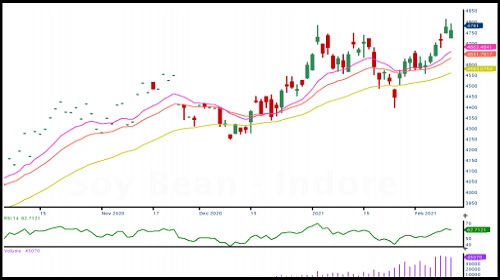
COTTON
* The US Department of Agriculture has scaled up its global cotton production estimate for 2020-21 (Aug-Jul) to 114.1 mln bales (1 US bale = 218 kg) from 112.9 mln bales pegged in January. The upward revision is mainly due to rise in production in China. The agency has raised China's cotton output estimate to 29.0 mln bales, against 27.5 mln bales a month ago. The agency has marginally cut its estimate for output in India to 29.0 mln bales, compared with 29.5 mln bales projected a month ago. Global cotton consumption is seen at 117.2 mln bales, up from 115.7 mln bales pegged last month. Exports are now seen at 43.9 mln bales, compared with 43.6 mln bales. Ending stocks are seen lower at 95.7 mln bales compared with 96.3 mln bales. The agency retained its export estimates for India at 5.0 mln bales. India's domestic demand for the current season is pegged at 24.3 mln bales. Ending stock for the ongoing season is seen at 18.1 mln bales, against 19.4 mln bales.
* The Cotton Association of India has raised its production estimate to 36.0 mln bales (1 bale = 170 kg) from 35.9 mln bales projected in the previous month, for the ongoing 2020-21 (Oct-Sep) season. In 2019-20, the association had pegged the crop at 36.0 mln bales. It has maintained its estimate for exports at 5.4 mln bales (1 bale = 170 kg) for the ongoing 2020-21 (Oct-Sep) season. In the current marketing year, India has shipped around 2.9 mln bales up to January. Domestic consumption is estimated at 33.0 mln bales in 2020- 21, while imports are pegged at 1.4 mln bales. Ending stocks in the country for the 2020-21 season are seen at 11.5 mln bales, it said. Of the total crop, around 25.5 mln bales have arrived till January.
* The USDA has cut its estimate for India's 2020-21 (Aug-Jul) cotton output to 28.9 mln bales (1 US bale = 218 kg) due to lower yields. It had pegged the output at 29.5 mln bales in December. The impact of excess Northeast monsoon rains and increasing incidence of pest infestation will likely negatively impact yields, especially in the state of Telangana said in its January report. Cotton consumption in the current season is seen at 23.6 mln bales, against 23.0 mln bales projected in the previous month. Strong export demand for cotton yarn and lower prices of the fibre in the domestic market led to rise in consumption. The agency has raised its export estimate to 5.0 mln bales, compared with 4.8 mln bales a month ago. Imports are seen steady at 1.0 mln bales. In 2020-21, the closing stock of cotton for the country has been pegged at 18.9 mln bales in January, compared with 20.4 mln bales projected in December.
* The International Cotton Advisory Committee has raised its forecast for global prices in 2020-21 (Aug-Jul) due to lower production estimate and firm demand in its February report. They revised upwards its price forecast for Cotlook A index, a global benchmark for prices of raw cotton, by 4 cents from the previous month to 73 cents per pound. Global production for the ongoing season is currently estimated at 24.1 mln tn, down 8% from the previous season. The fall in output estimate has largely been attributed to a smaller crop in the US, Brazil, and Pakistan. Production in India is expected at 6.20 mln tn, compared with 6.07 mln tn in the previous year. The committee has estimated global consumption at 24.1 mln tn, compared with 22.8 mln tn last year. Similarly, global exports are seen higher at 9.3 mln tn, compared with 9.0 mln tn year ago. Global ending stock is estimated at 21.2 mln tn for the current season.
* In the Union Budget for 2021-22 (Apr-Mar), Finance Minister Nirmala Sitharaman proposed customs duty of 5% on cotton and 10% on cotton waste. She also proposed an Agriculture Infrastructure and Development Cess of 5% on cotton, taking the overall customs duty to 10%. Customs duty on raw silk and silk yarn or yarn spun from silk waste has been increased to 15% from 10% earlier.
• The UK-based Cotton Outlook has marginally raised its estimate for global output in 2020-21 (Aug-Jul) by 32,000 tn to 24.02 mln tn in its January report. The estimate has been scaled up largely due to upward revision in production in China. A slight reduction in production is seen in the US. The agency has maintained its estimate for India's cotton crop at 6.2 mln tn for the ongoing season. Production in the US is seen at 3.3 mln tn, against 3.5 mln tn projected a month ago. Global cotton consumption in 2020-21 is seen at 24.5 mln tn, against 24.3 mln tn projected the previous month. Consumption is seen higher on likely rise in demand from India and Turkey. Ending stocks of the fibre for 2020-21 are seen at 466,000 tn, against 325,000 tn projected last month.
* Cotton yarn prices in India have risen sharply mainly due to improved demand from the domestic downstream segments as well as continued strong overseas demand during Oct-Dec, rating agency ICRA said in a release.
* Cotton production in Gujarat is likely to fall 14% to 7.4 mln bales in 2020-21 (Jul-Jun) due to a sharp decline in acreage, according to the state farm department's second advance estimate. Cotton acreage in Gujarat is at 2.28 mln ha in the current season against 2.65 mln ha last year. The decline in acreage is mainly due to the shift to other lucrative crops like groundnut.
* Global cotton prices will likely average higher on a year-on-year basis in 2021 amid a broader and deeper economic recovery, Fitch Solutions says in a note. It is forecasting cotton prices to average 70c a pound in 2021. Lower global supply in 2020/21 coupled with the sharp uptick in China's import demand will keep prices supported.
* The much awaited and long delayed export agreement between Cotton Corp of India and Bangladesh government is now in its final stage and may materialise by December, said Pradeep Agarwal, chairman and managing director of the organisation.
* The area under major kharif crops so far in 2020-21 (Jul-Jun) was at 111.7 mln ha, up nearly 5% from a year ago, farm ministry data showed. Farmers have sown cotton across 13.04 mln ha in the 2020-21 (JulJun) season, up by 2.1% from a year ago, as of 25th Sept., farm ministry.
• India's cotton output in the 2020-21 (Oct-Sep) marketing year is seen at 38.0 mln bales (1 bale = 170 kg), up 4% on year, according to traders' pegs 2020-21 cotton crop at 37.1 mln bales vs 35.5 mln bales.
* Cotton production in Gujarat is likely to fall by 6% to 8.2 mln bales in 2020-21 (Jul-Jun) due to a sharp fall in acreage, according to the first advance estimates released by the state's farm department. Cotton acreage in Gujarat is down at 2.28 mln ha in the current season compared with 2.65 mln ha last year. The fall in sowing area is mainly due to the shift to other lucrative crops like groundnut.
* Govt cuts 2019-20 cotton output view to 35.5 mln bales vs 36.0 mln.
* The government has raised the support price of medium staple cotton by 260 rupees per 100 kg to 5,515 rupees, and that of long staple by 275 rupees to 5,825 rupees.
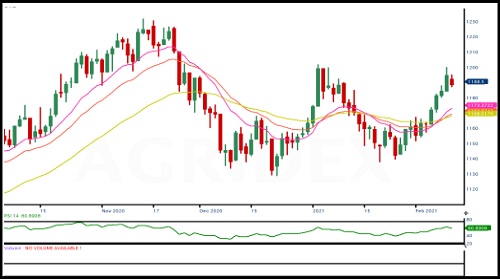
OTHERS
* Chana March futures on NCDEX declined on Wednesday on profit booking.
* The farm ministry has approved the procurement of 167000 tonnes of chana from Karnataka in 2021-21 under the price support scheme according to the NAFED.
* The center is expected to purchase about 600000 tons of Chana harvested in 2020-21 under the price support scheme from the farmers in Madhya Pradesh.
* Farmers in the country have sown rabi chana across 11.2 million hectares so far, up 4.4 per cent compared to same period last year , farm ministry data showed.
* The National Agricultural Cooperative Marketing Federation of India has offered discount of 5-10% on chana produced in the 2019-20 (Jul-Jun) rabi season, and subsequently procured by the agency at the minimum support price for that year, according to its website.
* Guarseed and Guargum March futures on NCDEX ended down on Wednesday.
* India’s guar gum exports improved in the month of December 2020 by 32% to 17,644 tonnes compared to 13,414 tonnes during November 2020 at an average FoB of US $ 1849 per tonne in the month of December compared to US $ 1611 per tonne in the month of November 2020. However, the gum shipments were down -1% in December 2020 compared to the same period last year. Of the total exported quantity, around 4,914 tonnes is bought US, Russia (3,290 tonnes) and Germany (2,432 tonnes).
* India’s guar split exports fell in the month of December 2020 by -39% to 2,800 tonnes compared to 4,557 tonnes during November 2020 at an average FoB of US $ 955 per tonne in the month of December compared to US $ 1,390 per tonne in the month of November 2020. Further, the guar split shipments were up +32% in December 2020 compared to the same period last year. Of the total exported quantity, around 1,880 tonnes is bought China, US (800 tonnes) and Switzerland (120 tonnes).
* Steady to positive bias was witnessed in Indian natural rubber market on Wednesday. RSS4 grade rubber in the spot market firmed up on expectation of rise in demand in coming days. Cues from the overseas market, rise in crude oil prices and end of the peak production phase supported the sentiments as well.
* Kerala government is set to raise the guarantee price for RSS4 grade rubber under Rubber Production Incentive Scheme from existing Rs.150 a kg to Rs.170 a kg with effective from April 1, 2021 as per the state budget presented on Jan 15, 2021.
* Global production of natural rubber in January is expected to recover to 1.19 mln tn from 1.05 mln tn a year ago, the Association of Natural Rubber Producing Countries said in a release. Globally, consumption of natural rubber during the month is likely to increase 15.5% on year to 1.17 mln tn, the release said. During Jan-Nov 2020, global production of natural rubber contracted 8.3% on year to 11.37 mln tn, while global consumption posted a fall of 7.9% on year to 11.66 mln tn. For December 2020, production of natural rubber is likely to fall 8.9% on year. However, consumption is likely to recover 3.6% to 1.16 mln tn.
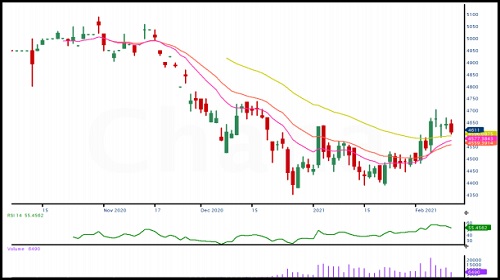
To Read Complete Report & Disclaimer Click Here
For More Geojit Financial Services Ltd Disclaimer https://www.geojit.com/disclaimer
SEBI Registration Number: INH200000345
Views express by all participants are for information & academic purpose only. Kindly read disclaimer before referring below views. Click Here For Disclaimer















